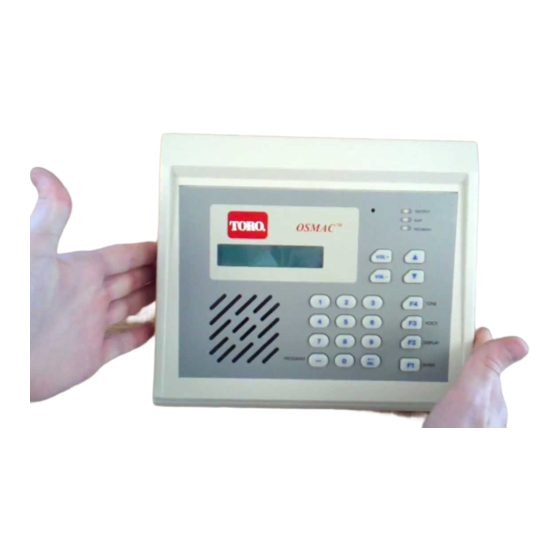Summary of Contents for Toro OSMAC
- Page 1 ® OSMAC Base Station Digital Wireless Paging System User’s Guide Installation Programming Operation Commands RELEASED Version ©Toro 2005-2005...
- Page 2 RELEASED Version ©Toro 2005-2005...
-
Page 3: Table Of Contents
Appendix A – OSMAC Configuration Commands ........ -
Page 4: Introduction
The OSMAC Base Station operates in one of two basic modes: Page Mode and Program Mode. The Page Mode is used to send command codes to a selected satellite controller or group of satellites. The base station can also be used with a two-way radio to communicate and send satellite commands. -
Page 5: Display/Indicators
Sending a Satellite Command The OSMAC Base Station waits for satellite address number input when the “PAGER NO =” prompt is displayed. Using the keypad, enter the satellite address number you wish to send a command to. Once the satellite address number is entered, press the F1 key to transmit. -
Page 6: Rear Panel Connections
Base Station. Serial I/O Ports The OSMAC Base Station has two RS-232 Serial I/O ports. These ports can be used to connect the base station to a central controller such as SitePro or TouchNet. Auxiliary/Alarm Connector A 15-pin D-sub female connector is provided on the back of the unit and labeled as ALARMS. -
Page 7: Installation
Locating the OSMAC Base Station The OSMAC Base Station is designed for an indoor office environment. Choose a location where the ambient air temper- ature is be between -10C and +40C, and relative humidity in the 20 – 80% range. Operation outside of this range may cause damage to the unit. -
Page 8: Base Station Operation
9, the three digit address and the satellite command to be sent, can be entered all at once without waiting for the voice prompts from the OSMAC Base Station. This allow users that are familiar with the OSMAC Base Station operation to enter commands more quickly. -
Page 9: Telephone Operation
The base station will disconnect the phone line and report "TIME-OUT ERROR" if at any time the user takes more than a few seconds to make an entry on the telephone keypad. The user must have to call the OSMAC Base Station again if telephone operation is desired. -
Page 10: Advanced Hand Held Radio Operation
The DTMF tones being sent to the phone line will be heard to confirm dialing. 4. Once the called party answers, the phone VOX circuit takes over. When the called party speaks, OSMAC Base Station transmits his or her voice. -
Page 11: Receiving Phone Calls
Phone Calls at the Two-Way Radio The OSMAC Base Station can also be used to route telephone calls from the telephone line to a two-way radio. To initiate a phone call from the telephone interface: 1. Dial the phone number of the telephone line connected to the OSMAC Base Station. -
Page 12: Program Mode
To exit the Program Mode, press the – (dash) key. Any changes you make will automatically be saved. Note: When the OSMAC Base Station is in the Program Mode and no keyboard entry is made within two minutes, the base station will revert back to the Page Mode, with the exception of test command. -
Page 13: Assigning Satellite Groups
Y if you wish to save the changes. If not, press an œ œ ¤ ¤ or ƒ ƒ arrow key to display N, then press the F1 key. 7. The OSMAC Base Station restarts back at the “PAGER NO =” prompt. It will automatically increment to the next satel- lite address number. -
Page 14: Sending Test Commands
7. To finish entering satellite address numbers to this group, press the – (dash) key. Sending Test Commands The test command mode may be used to check the range of the system. With this mode, the OSMAC Base Station will automatically generate a command to satellite address number 0 every ten seconds. -
Page 15: Autodial Memory
To set up the Alarm commands, perform the following steps: 1. Select the Program mode by pressing the – (dash) key on the keypad. The OSMAC Base Station will prompt you to enter the password. Press 7 5 3 1 and the F1 key. -
Page 16: Appendix A - Osmac Configuration Commands
Busy Channel Lockout If this mode is enabled, then the OSMAC Base Station will not transmit if the channel is busy. This may be desirable in order to avoid interfering with other users on the radio channel. This mode can be disabled when too much activity on the channel exist and commands cannot be sent out in a timely manner. - Page 17 Carrier Squelch operation may be desirable if there are no other users on the channel and there are no interference. In this mode, the two-way radio users will be able to hear the command signals transmitted by the OSMAC Base Station. To enable this mode, press 1 to select CARRIER ONLY.
-
Page 18: Appendix B - Hand Held Radio Command Codes
25 26 27 turns on stations 25, 26 and 27 for 2 hours, 30 minutes and 45 seconds. 7540 Turns off all stations (specified satellite only). 7542 Turns off all stations using the sequential shut-down procedure. RELEASED Version ©Toro 2005-2005... - Page 19 22 or Sends command 752302. Shuts off current station being tested and decrement by two for new sta- tion. 0 7520 or 9 xxx Sends command 7520 to the last satellite, removing it out of test mode. RELEASED Version ©Toro 2005-2005...
-
Page 20: Specifications
"How to Identify and Resolve Radio-TV Interference Problems". This booklet is available from the U.S. Government Printing Office, Washington, DC 20402. Stock No. 004-000- 00345-4. International: This is a CSPR 22 Class B product © 2004 The Toro Company, Irrigation Division Form Number 373-0099 Rev. B RELEASED Version...









